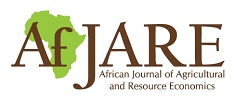Optimisation of benefits from agriculture and wildlife land uses by wards in CAMPFIRE areas in Zimbabwe.
Emmanuel Mwakiwa
Abstract
To arrest the ongoing ecological disaster in the country, the government of Zimbabwe implemented the Communal Areas Management Programme for Indigenous Resources (CAMPFIRE). Through the CAMPFIRE programme, each ward could benefit from two land uses – agriculture and wildlife. The ward must make a choice on land uses, in other words how much land to allocate to wildlife and how much to agriculture. When a hunting area belongs to one ward, the outcome is desirable; whereas if it belongs to two wards, it becomes complicated. We modelled the two scenarios: Scenario 1 – hunting area belonging to one ward; and Scenario 2 – hunting area shared by two wards. We used Pontryagin’s maximum principle to solve the models analytically and to carry out comparative statics. We also applied the results to the study areas using secondary data. The results from the analysis suggest that there is a need to make it mandatory for communities who bear the cost of wildlife management to share in the revenue from wildlife.
